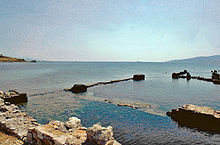Kenchreai
Kenchreai ( Greek Κεγχρεαί , also Choros Kechrees ), today Kechries ( Greek Κεχριές ), was one of the ancient ports of the city of Corinth , located on the Saronic Gulf in the Peloponnese (Greece). In the Bible he appeared in the spelling Kenchreae or Kenchreä .
history
Since the Corinth Canal did not yet exist in antiquity, the ships were unloaded in Kenchreai, towed across the Diolkos and reloaded in Lechaion on the Gulf of Corinth , the same thing going in the opposite direction. The port has always been owned by Corinth, apart from a brief occupation by Kassandros in 315 BC. After Apuleius († around 170 AD), in whose novel Metamorphoses the Isis temple of Kenchreai played an important role, there was lively activity here. Paul set out from here, where there was a Christian community, with a deaconess Phoibe, mentioned in Romans , for Ephesus . Earthquakes (365 and 375 AD) caused severe destruction and a subsidence of the ground. In late Byzantine times the port was meaningless.
The finds
Some remains of a house are still visible on land. The sea was about the construction period about four to five meters lower than today. The remains of the Temple of Isis , which was converted into a basilica , are now partly under water. 50 wooden containers with painted glass plates were also found here, which were stored here after arriving at the port and destroyed in the 375 earthquake (now in the Isthmia Museum ). Chamber graves with frescoes were found in a Roman cemetery to the north of the port. 600 m northeast of the ancient port are the foundations of a Roman monumental grave from the 1st century.
Quote
Apuleius , Roman author († around 170 AD) and himself an initiate in various mystery cults, mentions the Isis cult of Kenchreai in his novel Metamorphoses . After his initiation, his protagonist Lucius says about the secret initiation ritual:
“ Perhaps you are curious, dear reader, asking what has now been said and done! - How I would like to say it, if I could say it! How holy should you know if you were allowed to hear! But the tongue and the ear would have to pay hard for the sacrilege! [...] I went to the dividing line between life and death. I entered Proserpina's threshold, and after having passed through all the elements, I returned again. At the dead of midnight I saw the sun shine in its brightest light; I saw lower and higher gods face to face and worshiped them nearby. "
literature
- Christopher Mee, Antony Spawforth: Greece. To Oxford Archaeological Guide . Oxford University Press, Oxford 2001, pp. 163-165 .
- Rudolf Scheer: Kenchreai . In: Siegfried Lauffer (Ed.): Greece. Lexicon of Historic Places . Verlag CH Beck, Munich 1989, p. 332 .
- Robert Scranton: Kenchreai Corinthia, Greece . In: Richard Stillwell et al. a. (Ed.): The Princeton Encyclopedia of Classical Sites. Princeton University Press, Princeton NJ 1976, ISBN 0-691-03542-3 .
- Christoph vom Brocke: Greece , EVA, Leipzig 2007, pp. 238–241.
Web links
- The American Excavations at Kenchreai (overview of the excavation)
Individual evidence
- ↑ Apuleius The Golden Donkey , p. 249.
Coordinates: 37 ° 53 ′ 3 ″ N , 22 ° 59 ′ 48 ″ E

